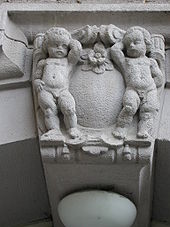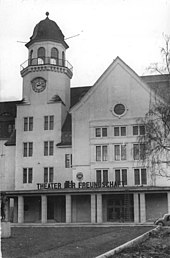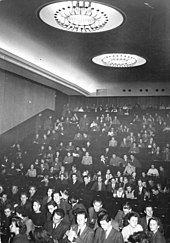Theater on the Parkaue
| Theater on the Parkaue | |
![Academy of Dramatic Arts]]; Photo taken in 2007.](https://upload.wikimedia.org/wikipedia/commons/thumb/5/5a/Theater_an_der_Parkaue_Berlin_au%C3%9Fen_1.jpg/260px-Theater_an_der_Parkaue_Berlin_au%C3%9Fen_1.jpg)
|
|
| location | |
| Address: | Parking lots 23–29 |
| City: | Berlin-Lichtenberg |
| Coordinates: | 52 ° 31 '1 " N , 13 ° 28' 38" E |
| Architecture and history | |
| Opened: | November 16, 1950 (theater) |
| Architects: |
Johannes Uhlig (school), Wilhelm Grieme (school), Waldemar Alder and Waldemar Heinrichs (conversion to a theater) |
| Named after: |
Parkaue (1948: Theater of Friendship ; 1991–2005 carrousel Theater an der Parkaue since August 2005: Theater an der Parkaue ) |
| Internet presence: | |
| Website: | www.parkaue.de/ |
The Theater an der Parkaue - Young State Theater Berlin in Berlin-Lichtenberg is one of the largest state theaters for young audiences in Germany . The repertoire is aimed at children from four years of age, school classes of all ages, teenagers and young adults, families and individual visitors of all ages.
The theater occupies half of a school building built in the early 20th century and was founded in 1948 by order of the Soviet military administration . The other half of the school building was the children's house or the central house of the young pioneers (also known as the “ pioneer house ”). The building ensemble is a listed building .
History of the house: school
Higher School
The U-shaped building complex with the house address Parkaue 23-29 was built in 1910/1911 as a high school for boys ( grammar school ) according to the designs of the city building councilor Johannes Uhlig and the architect Wilhelm Grieme . Architecturally, the four-story plastered building is based on the Renaissance ; Directly connected to it is the former rector's house on the left with a small wall fountain.
As part of the National Socialist measures to instrumentalize education and upbringing, the school was renamed on January 27, 1934 after the Reich Minister for Public Enlightenment and Propaganda Joseph Goebbels . The building survived the war almost undamaged.
Children's House 1948–1995
After repairs and the start of school operations, on June 30, 1948, the Soviet Military Administration in Germany (SMAD) issued Order 65, an order to rededicate the school building for cultural purposes. After fascism and war , children and young people were to be taught new cultural content and offered leisure opportunities.
The Bauhaus student Waldemar Alder and his partner Waldemar Heinrichs worked out the renovation and expansion plans. The new interior was manufactured in the Deutsche Werkstätten Hellerau . After completion, the former school became the children's house in 1949 as a branch of the "House of Culture of the Soviet Union". On the basis of order 65, rooms were set up for instrumental lessons , choral singing , folk dance , ballet , drama , languages, history, natural history, photography and applied arts . The top floor was converted into a miniature observatory . Workshops for wood, metal and electrical engineering , studios for painting , sculpture and ceramics as well as a library, a reading room, a cinema and a theater served from then on for the leisure activities of the children and young people.
On May 25, 1950, the children's house was handed over to the GDR and was named the Central House of Young Pioneers . After the space flight of the second Soviet cosmonaut German Titov and his visit to Berlin in 1961, the house was named the Central House of Young Pioneers "German Titow" .

Around 1980 the Berlin magistrate provided the pioneer house with a disused Soviet aircraft that was set up in an open space next to the building and, among other things, housed a cosmonaut studio.
Until the political change in the GDR , the pioneer house served as a home for many working groups . In 1982, more than 2,000 children regularly and free of charge visited the 130 working groups, including electrical engineering, chemical engineering, ship model building, pioneer driving school, the cosmonaut club, the international friendship club, the art education working group, symphony orchestra, folk instrument orchestra, dance, ballet, choir, pioneer theater, cabaret, Puppet theater, shadow play, science, chess, philately, young historians, animal breeding, various sports groups were part of it. 38 full-time and 90 voluntary educators led the interest groups. On an annual average, the Pionierhaus counted 360,000 young visitors, but also foreign guests who were able to find out more about these leisure activities.
When the Pionierhaus was closed in 1990, there were briefly different uses, for example the Lichtenberg Music School settled in some rooms, and youth clubs rented rooms, but many rooms were empty. The cosmonaut studio plane disappeared at some point.
Academy for Dramatic Art and Das Weite Theater from 1995
The cultural projects "Ernst Busch" University of Dramatic Arts Berlin , Dept. Puppetry Art , and the association Das Weite Theater für Puppen und Menschen e. V. found new accommodation in the rooms.
History of the house: theater
Theater of Friendship 1948–1991
The right (southern) wing of the building, with the former auditorium, was rededicated as a theater for children and young people, which was named Theater of Friendship .
For the opening of the new theater, the performance of You're the Right One was planned by the first director, Hans Rodenberg , but it had to be postponed due to problems with the procurement of materials. (The play was performed in the theater of the House of Soviet Culture (from 1952 then Maxim Gorky Theater )). The new Theater of Friendship was inaugurated on November 16, 1950.
- Intendant until 1991
Paul Lewitt (1952–1953) and Josef Stauder (1953–1959) followed Rodenberg as artistic director . In 1959, Ilse Rodenberg took over the directorship of the first pure children's and youth theater in Berlin for almost 15 years. From 1973 Klaus Urban, Siegfried Wein and Siegfried Nürnberger followed as artistic directors and Horst Hawemann , Wolfgang Engel , Mirjana Erceg, Carl-Herrmann Risse and Konrad Zschiedrich as directors on this stage. Generations of children and adolescents visited the diverse performances, which were often created by young actors.
In 1980 the square in front of the theater was given the honorary name Hans-Rodenberg-Platz , which it wore until March 17, 1995.
carrousel Theater an der Parkaue 1991–2005
Under the management of Manuel Schöbel and chief director (1992–1997) Peter Schroth , the theater expanded its repertoire to include up to 30 productions for all age groups on three stages, and the theater opened up to previously unplayed Western European drama. An evening schedule was established and spectacle forms were successfully tested ( schoolyard stories : the seven authors were honored with the Brothers Grimm Prize of the State of Berlin , Black Nights , Grimm Total ). The theater pedagogy , already at the center of the work in the theater of friendship under Kristin Wardetzky , has been converted into a game pedagogy department. Under the new name carrousel Theater an der Parkaue (1991), the theater became the main venue for the German children's and youth theater meeting “Just a moment!”, Which is carried out every two years by the Children's and Youth Theater Center of the Federal Republic of Germany.
Together with the chief dramaturge Odette Bereska and the marketing director Dirk Neldner , Schöbel turned the theater into a center for international cultural projects ( European Schoolyard Stories 1999/2000, Children's Play Out of Bounds : Coproduction with the Australian ATYP for the Sydney Festival 2002, Magic Net 2001 -2005). In 2004 the plans of the Berlin Senate to cut the subsidies for the children's and youth theater of the State of Berlin by half provoked fierce opposition. After employees, spectators, national and international friends and sponsors of the house protested under the heading “Whole people need a whole theater”, the Senate withdrew its plans.
Theater an der Parkaue from 2005
With the appointment of Kay Wuschek as artistic director and Sascha Bunge as senior director , the theater was given the name Theater an der Parkaue in accordance with its postal address in August 2005 . Around 90 employees, including 17 ensemble actors, work here (as of the end of 2015).
The theater offers projects such as the House of Many , in which children and young people have the opportunity to work artistically, as well as four theater clubs and workshops that deal with dance, text, play, performance and theatrical means.
The Theater an der Parkaue is one of the four subsidized theaters in Berlin run as directors (together with Maxim-Gorki-Theater , Volksbühne , Deutsches Theater ). They are directed by state theater directors. Other theaters such as the Schaubühne, the Berliner Ensemble and the Grips-Theater are private theaters , but they also receive grants from the Berlin Culture Fund.
In the 2016/2017 season, productions took place at other locations due to the renovation of two stages. In addition to the Prater in Kastanienallee in the Prenzlauer Berg district as the main venue, the carpentry of the Deutsche Oper and the Kulturhaus Karlshorst were also used. Stage 3 directly in the theater building was also rebuilt by 2015.
After two years of renovation work, the Theater an der Parkaue opened stages 1 and 2 in November 2017, so that all productions since the 2017/2018 season have taken place on site again.
Florian Stiehler has been the managing director and acting director of the theater since summer 2019.
In the course of the 2017/2018 season, the house welcomed the eight and a half millionth viewer in almost 600 productions in its 67-year history.
literature
- Christa Heese: From school to the children's home . In: Berlin monthly magazine ( Luisenstädtischer Bildungsverein ) . Issue 10, 2000, ISSN 0944-5560 , p. 76-82 ( luise-berlin.de ).
- The architectural and art monuments in the GDR. Capital Berlin. Vol. II. Institute for Monument Preservation at Henschelverlag, Berlin 1987.
- Documents in the local history museum Lichtenberg
- Central House of the Young Pioneers. In: Berliner Zeitung , around 1982 (only an extract available)
Web links
Individual evidence
- ↑ Entry in the Berlin State Monument List
- ↑ Central House of the Young Pioneers. Ceremonial handover of the children's house in Berlin-Lichtenberg to the Central Council of the FDJ. In: Neues Deutschland from May 26, 1950, p. 2.
- ↑ (Description: The photo shows five boys in the so-called cosmonaut cabinet. Around 1980, the Berlin magistrate provided the pioneer house with a disused Russian aircraft, which was set up in an open space next to the pioneer house and included, among other things, a cosmonaut studio). Institute for Contemporary History, photo collection, accessed on October 7, 2019 .
- ↑ Hans-Rodenberg-Platz . In: Street name lexicon of the Luisenstädtischer Bildungsverein
- ↑ Leonardo-da-Vinci-Gymnasium: The subject performing game. (PDF; 673 kB) (No longer available online.) 2008, archived from the original on June 12, 2015 ; accessed on January 1, 2019 .
- ↑ ( Page no longer available , search in web archives: Sydney Morning Herald )




